

European
Nuclear Society
e-news
Issue 18 October 2007
Not so long ago sensible discussion about nuclear energy was often marginalised, especially in anti-nuclear countries. In fact it was, and to some extent still remains, a no-go issue; a taboo subject banished from the mainstream of conversation. The tragic events of Chernobyl stirred up a whirlpool of understandably emotional reactions and created in the minds of many a view of nuclear energy that was largely coloured by irrational fears, inherited misconceptions and doomsday scenarios. The opponents of nuclear energy, skilled at exploiting the effects of emotive language and imagery, still encourage this mindset in order to keep nuclear energy off the agenda. They espouse a cause based more upon ideology than upon rational argument or fact. And yet, slowly but surely, as the scars but not the lessons of Chernobyl begin to fade, and as the strong security of supply and environmental credentials of nuclear energy have come to the fore, the whole nuclear energy question is once again a legitimate and legitimised subject of debate. Even the anti-nuclear brigade now openly refer to the “dangers of the nuclear renaissance” – recognition in itself that nuclear energy is back and no longer a taboo subject to be dismissed out of hand.
The recent nuclear revival in Europe and beyond has been fuelled by a new spirit of pragmatism; a revitalising dose of good old-fashioned common sense. Governments, economists and environmentalists, with admittedly varying degrees of enthusiasm, have come to the inevitable conclusion that there is no way today’s security of supply and climate change conundrum can be solved without nuclear energy as a major part of the equation. Accordingly, public perceptions of nuclear energy have subtly changed as reason, greater environmental consciousness and practical expediency have gradually gained the upper hand over entrenched thinking and preconceived ideas.
Meanwhile, policy-makers in Brussels have launched a series of initiatives, like the High-Level Group on Safety and Radioactive Waste and the European Nuclear Energy Forum (ENEF) that have effectively institutionalised nuclear energy’s return to the top of the EU’s energy agenda. At this rate it’s those that want to maintain nuclear energy’s taboo status that might soon appear marginalised and blind to reality.
But what does this mean for the scientific and research community? How much of the new political will and energy invested in the nuclear revival will filter through to those leading the research drive that is so essential for maintaining it? How, if at all, will the daily life of the average nuclear researcher be affected? Well, a new initiative by the European Commission could prove to be significant. The launching of the Sustainable Nuclear Energy Technology Platform (SNETP) on 21 September should help give fresh focus and impetus to the European nuclear research effort. The overriding aims of the SNETP are to facilitate closer integration between researchers and industry and to enable the definition and implementation of a Strategic Research Agenda (SRA) and its corresponding Deployment Strategy (DS). With its fundamental emphasis on greater specialisation in high-tech areas, it should also help to maintain Europe’s R&D leadership in the nuclear research sector and help deliver nuclear energy’s contribution to the Strategic Energy Technology Plan (SETP), which aims to develop research into all low-carbon technologies in the EU.
A strategic document entitled SNETP: A Vision Report was published to coincide with the launch. This report, which was compiled with the support of industry, research institutes and the Euratom Scientific and Technical Committee, underlines the special contribution made by nuclear energy to ensuring security of energy supply, promoting competitiveness and fighting climate change. It also provides a roadmap for the creation of the Strategic Research Agenda (SRA). The SRA roadmap highlights the start-up by 2020 of a new breed of fast reactors (Generation IV), advanced recycling processes and the production of alternative fuels, like hydrogen. The SRA and the DS will “ensure that nuclear fission energy is generated in a manner that meets the criteria for sustainable development in strict compliance with safety requirements.” The Vision Report also stresses the need for increased resources for education and training in nuclear engineering.
At last, nuclear energy research can compete on a level playing field with other major energy sources because now it too has its own EC-supported technology platform. Like all technology platforms, the SNETP will focus on increased investment in research into high-tech areas, enhance coordination of pan-European research efforts and promote increased technology take-up by industry. To make this happen it will promote a shared stakeholder vision, mobilise public and private funds, impact positively upon a wide range of policies and avoid continued fragmentation of research efforts.
The SNETP is ultimate recognition by the European institutions that nuclear is a major part of Europe’s energy future. Of course, it’s early days yet and only time will tell whether the SNETP will deliver on its commitments. But at least it’s a start. Without the political will to make this new research commitment work the fine words will remain just that – words. ENS NEWS looks forward to hearing from its readers involved in the front line of research what they think of this EU initiative and how they think it might affect their lives.
ENS NEWS N° 18 kicks off with the traditional Word from the President; on this occasion Frank Deconinck’s contribution comes in the form of the integral text of the welcoming address that he and Marcel Maris delivered at the ENC 2007 conference, in Brussels, in September. In his usual thought-provoking manner Andrew Teller then focuses on how differing interpretations and expressions of logic can help explain the inconclusive state of the debate between the supporters and opponents of nuclear energy.
The Events section of ENS NEWS N° 18 first focuses on the objectives, programmes and conclusions of ENC 2007, before turning to the future by providing basic information and calls for contributions for the following ENS flagship conferences: PIME 2008 (Prague, 10-13 February), RRFM (Hamburg, 2-5 March) and NESTet 2008 (Budapest, 4-9 May).
In the Member Societies and Corporate Members section there are a number of reports that combine technical data and analysis with information about significant political developments affecting nuclear researchers. First up is a detailed analysis of a new concept in high-pressure boiling water reactor (HP-BWR) design and how it compares to traditional BWRs. Our colleagues from the Technical University in Vienna then provide ENS NEWS with the abstract that they presented at the recent Nuclear Energy for New Europe Conference, which took place in Slovenia, in September. The subject under the spotlight is Can Austria Survive without Nuclear Energy? The next contribution is a report by the Editor on the recent signing by EC Science and Research Commissioner, Janez Potocnik, and the CEA in France, of a European Charter for Researchers and a Code of Conduct for the Recruitment of Researchers. This Charter is a significant political development that should have positive repercussions in other countries because it underlines the attractiveness of the EU as a breeding ground for research excellence and stresses how a career in research is an interesting and fulfilling career for talented young scientists; the scientists whose skills will be needed to sustain the nuclear revival and signpost the future of nuclear research in general.
The Croatian Nuclear Society (CNS) then provides readers with information about the 7th International Conference of the CNS, which takes place in Dubrovnik, from 22-25 May 2008. The title of the conference is The Nuclear Option in Countries with Small and Medium-sized Electricity Grids.
In this edition of ENS NEWS we have a number of reports from the Young Generation network. Two interesting conference reports put the spotlight on a subject of great importance to the nuclear science community – and especially young scientists – education and training. This is a subject that ENS NEWS has banged on about before and it remains central to defining the future of nuclear science and research for years to come. The first conference is the ICEM conference that took place in Bruges, Belgium, in September 2008 and the other one is the BNES/INucE congress, which took place in Manchester, UK, in June 2008.
The European Institutions section provides a detailed report on the recent launching of the Sustainable Nuclear Energy Technology Platform (SNETP). This landmark EU initiative could have a fundamental affect upon the working environment and future direction of research into all things nuclear. It represents a significant political step and the nuclear community waits with interest how things will unfold. Watch this space!
True to tradition, ENS NEWS N° 18 wraps up proceedings a couple of reports from NucNet.
Enjoy your ENS NEWS and don’t forget to give me your feedback on this latest edition.
|
|
|
http://www.euronuclear.org/e-news/e-news-18/presidents-contribution.htm


As those of you who attended ENC 2007 (from 16-20 September 2007) already know the conference was co- chaired by ENS President Frank Deconinck and Marcel Maris, Chairman of the Belgian Nuclear Society. In their joint welcoming address the chairmen highlighted the main structure, themes and objectives behind the extensive ENC 2007 programme, underlined the great work carried out in support of the conference by its sponsors and co-organisers, as well as by the numerous exhibitors that contributed to the impressive industry and research exhibitions. Above all the chairmen emphasised the special ethos of this the latest edition of what is a major event on the international nuclear research agenda - to share new knowledge and experience, to focus on solutions and to seek to promote innovative, cutting edge and multidisciplinary research that will provide positive results for industry and for society as a whole. The ENC 2007 message Inspire yourself …and others says it all.
Here is the welcoming address delivered by Frank and Marcel.

Distinguished guests, ladies and gentlemen
We would like to welcome you wholeheartedly to Nuclear Conference 2007 conference and hope that by attending this 3-day conference you will indeed inspire and be inspired.
This European Nuclear Conference has been created to provide an increased focus on research, while at the same time calling our attention to the broader context in which, we think, the nuclear world should be seen.
The Programme Committee, which we would like to thank for the superb job that it has done, has put together a programme based on three central parallel tracks: "New reactor & energy technologies", "Fuel cycle and nuclear operations" and, last but not least, "Medical nuclear applications".
In the “New reactor and energy technologies” track the topics under discussion include advanced reactors, Generation IV reactors, an update on future concepts, countries' perspectives on nuclear energy policy and future projects and research reactors. They cover a range of subjects which take us from today’s feasible and improved designs, tools and technologies to a glimpse of what current developments will lead us to. In addition, 3 countries will present their individual views on nuclear energy policy. Finally, the presentations on “Plant life extension” and “Maintenance and operation” will address various aspects that are of fundamental importance to today’s plant operators.
The “Fuel cycle and operations” track will focus first on reprocessing, before turning its attention to advanced fuel designs and applications, core design and protection. It will conclude with new developments in fuel technology. After a session on decommissioning, there will be a number of sessions addressing various interesting aspects in the areas of waste and transport.
This year, we added a track on medical applications in ENC to emphasise the important role played by applications of nuclear science in diagnosis and therapy. As the subject is not a traditional ENC one we have invited some world-renowned experts to talk about radio-labelling and imaging technology, clinical applications and radioprotection.
It certainly is not our intention to compete with our scientific sister societies in the field. Instead, we want to create links between ENS and our sister societies, and inform our respective members about the exciting developments in adjacent fields of research and development. Too many researchers and industrialists working in nuclear energy are unaware of the developments in nuclear imaging, radio-labelling, radiotherapy etc... Vice-versa, the medical community may not always be aware of the most recent techniques or advances in isotope production and radiochemistry, radiobiology or radioecology. We hope that this conference will trigger a better understanding and increased collaboration between both.
The subjects of the plenary keynote presentation and debate sessions illustrate the broader context fairly well.
Today, Monday, these sessions will address:
The EU research policy
The politics of science and technology
Business’ and industries’ view on science and R&D policy, challenges and needs
Science as “living knowledge”: Education and training policy and knowledge management
Tomorrow you will be able to learn more about the following subjects:
“ The human factor in risk governance: aspects of awareness and responsibility,” “The benefits, costs and hurts of nuclear medicine” and “Social awareness." These sessions will not just be about receiving and processing the latest information – there will also be a strong emphasis on participation.
On Wednesday, the last session will address state-of-the-art European research policy in the field of nuclear and medical science and technology and science and society issues. It will include contributions on “Educational activities in the EMIL network: the Orsay technological and training platform for small nuclear imaging” and on “Research: a sine qua non for the nuclear sector.”
A programme of separate topical workshops is also offered to delegates and you are, of course, invited to participate in the workshops that deal with the subjects that interest you most.
We are very happy to see that the ENS Young Generation (YG) is also organising its own workshops. In addition, it will present a briefing on the presentations made in each of the 3 research tracks at the end of the conference.
Finally we would like to invite you to attend the plenary panel debate entitled: “Science and Society”, where we will have the honour of welcoming the Rector of the VUB - Prof. B. Van Camp and Maria-Laura Franciosi, an experienced journalist.

We are particularly grateful to our diamond sponsor, Suez, who has indeed a considerable vested interest in nuclear energy today – which will probably be even greater in the future.
We would also like to thank our Gold sponsor, AREVA, which is recognised worldwide as a major player in the field of nuclear energy.
Our special thanks also go to the American Nuclear Society (ANS) and the Belgian Nuclear Society (BNS), as well as to the IAEA and the OECD/NEA, who have all given their invaluable support to ENC 2007.
Finally, a great vote of thanks goes to the Vrije Universiteit Brussel, who agreed to host this conference on its campus.
We hope that you will indeed find great inspiration from attending the presentations, by visiting the research exhibition, the science café and the industry exhibition and by having a look at the poster gallery.
It is now our privilege to kick off ENC 2007 by introducing the first group of keynote speakers, who will address the subject of current and future EU research policy:
Mr. Roland Schenkel, DG at the Joint Research Centre of the EC, at Petten,
Mr. Fernandez-Ruiz, Director of Directorate J, Energy-Euratom, in the Directorate General “Research” of the EC and
Mrs. Maria Isabella Detand, who represents the Belgian Minister of Economy, Energy, Foreign Trade and Science Policy, Marc Verwilghen
Thank you very
much gentlemen for taking part in ENC 2007 – your presence is greatly
appreciated. The floor is yours.
Thank you.
http://www.euronuclear.org/e-news/e-news-18/listening.htm


The readers of ENS News who have followed this column might have noticed that its author is sometimes at pains to point out flaws in the reasoning of the anti-nuclear argument. If the said readers are somewhat sceptical, they might have also realised that highlighting the falsity of a piece of reasoning does not prove the falsity of the conclusion derived. They would be right. Anybody can reach a valid conclusion despite failures in one’s analysis of the question at hand. The assumption that the opponents of nuclear energy might be right at the end of the day despite the mistakes they regularly pile up in their reasoning cannot be lightly dismissed. Why is it then that I have been so far satisfied with exposing the shortcomings of the arguments put forward by the critics of nuclear energy? The answer to this question is not as obvious as one could be tempted to believe.
To understand why, we must first revert to the basic rules of logic and more precisely to the proper use of the logical operator named implication. This operator, which has been known about since the times of Aristotle at least, encapsulates the fundamental dissymmetry between correct and false reasoning. What it says in a nutshell is that true (or valid) and false (or invalid) premises behave differently as to the conclusions that can be derived from them: deriving a true conclusion from a true premise yields a true proposition while deriving a false conclusion from a true premise yields a false proposition. On the other hand, false premises can lead equally well to true or false conclusions. This is a pity. Life would be so much easier if false premises always led to false conclusions. If this were the case, maths teachers would have much less work with exams: they would just look at the answers of their students without bothering to go into the nitty-gritty of the calculations since a valid conclusion would stem only from a valid derivation. But this not being the case, they must also inspect the premises in order to confirm that the correct answer given by the student was indeed legitimately obtained, i.e. not reached by pure chance.
We have so confirmed that spotting a flaw in an argument does not mean that its conclusion is invalid. But we have also shown that it does not mean that it is valid either. Identifying a shortcoming does not therefore kill the argument but is a clear indication that the intended point remains to be made. This is much less than what the supporters of nuclear energy would like, but certainly more than its opponents hoped for. Now let us not delude ourselves: despite our concern for accuracy, we supporters of nuclear energy also make mistakes. When we make use of an invalid premise, the conclusion derived from it does not fall through but remains to be proven. This state of affairs mirrors the one described above: this is much less than what we would like, but certainly more than our opponents hope for.
At this point, the latter could try to seek support from Hans Jonas, the German philosopher whose thinking is at the root of the precautionary principle. They could try to claim that the potential consequences of the use of nuclear energy are so dire that it is preferable to consider their arguments valid even when they are not warranted by a watertight derivation. I am not aware that H. Jonas ever considered contravening the rules of logic; his main proposal was that adverse consequences be systematically given precedence over favourable ones. It can be easily imagined however that an enthusiastic interpretation of his recommendation could invite some to extend the process to bending the rules of logic itself. But this would not do. Flouting the rules of logic is equivalent to giving up the use of reason altogether in the decision process. The argumentation of the anti-nuclear could and would then boil down to claiming that “nuclear energy is bad because it is bad”. This is not however what they are doing. I infer from this fact that they implicitly accept the principle that any piece of reasoning must obey the rules of logic, in which case there is no escape from the fact their points remain to be made in all cases where there is a mistake in the way they try to make it.
The conclusion of this short analysis is that the inconclusive state of the debate between supporters and opponents of nuclear energy is to be put down to the strange behaviour of the logical implication: it leaves the protagonists all too often in a state of doubt and leads to certainty only in very few instances.
http://www.euronuclear.org/e-news/e-news-18/enc2007.htm

.jpg)
From 16-20 September, the European Nuclear Conference 2007 (ENC2007) took place at the VUB (Vrije Universiteit Brussel), in Brussels. ENC2007 is a biannual European Nuclear Society (ENS) event - the largest international conference of its kind on the European event calendar. It provided a platform for the nuclear science community to share their experiences, to learn about the latest developments going on in nuclear research and their practical applications and to exploit synergy among scientists, industry representatives, policy-makers and citizens on wider societal issues that impact upon how the nuclear science community carries out its work.
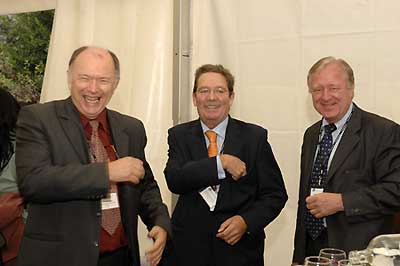
ENC2007 was organised in co-operation with the Belgian Nuclear Society, the IAEA and OECD/NEA, and with the support of the American Nuclear Society (ANS) and the VUB. Among the sponsors were Suez, AREVA and Westinghouse. The conference was co-chaired by the Conference Chairman, Marcel Maris (VUB), and by Frank Deconinck (ENS President).
A total of 700 delegates from 37 countries, including Korea, China, Japan and the US, gave ENC2007 not just a European but a truly global focus. The fact that the delegates represented many varied stakeholder groupings reflected the conference’s multidisciplinary approach. In addition, there were 30 stands representing 67 companies and research institutes at the ENC2007 exhibition. Exhibitors displayed their latest research data, promoted their scientific programmes and networked with delegates and visitors.
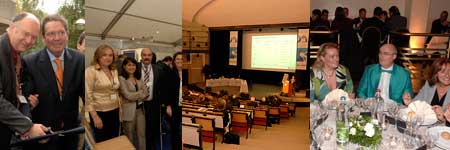
The ENC2007 conference programme was built around a number of plenary keynote sessions, panel debates and highly-focused topical workshops. Among the subjects covered during the plenary sessions were The Politics of Science and Technology, Business and Institutions’ View on Science and R&D, The Human Factor in Risk Governance, The Politics of Sustainable Development and The Benefits, Costs and Hurts of Nuclear Medicine. Among the keynote plenary speakers at ENC2007 were Roland Schenkel, Director General of the JRC; Luis Echavarri, Director General of OECD/NEA and Alain Bucaille, Senior Vice President for Research and Innovation, AREVA.
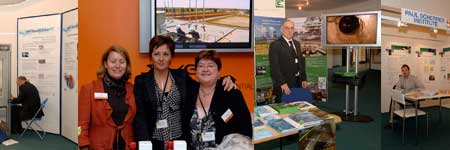
The topical workshops covered a large range of technical subjects, including new reactor and energy technologies, the nuclear fuel cycle (including waste, transport, dismantling and partitioning & transmutation), nuclear operations, medical applications, education and training and socio-economic, political and ethical issues. On the final day of the conference delegates had a choice of three technical tours to take part in: SCK-CEN’s research centre at Mol, Tihange NPP and the IBA (Ion Beam Application S.A.) facilities at Louvain-la-Neuve.
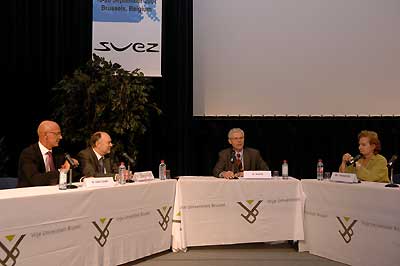
To get more information about the programme, the speakers and the abstracts visit the ENC2007 website at: www.enc2007.org (under “transaction”).
http://www.euronuclear.org/e-news/e-news-18/pime2008.htm


PIME 2008 will take place from 10 - 13 February, in Prague. PIME 2008 will offer a varied and top-quality programme that covers a range of issues of importance to nuclear communicators, including case studies highlighting the latest nuclear developments. It will feature a number of international experts and high-level speakers who represent all aspects of nuclear communications. Six interactive workshops will help you polish your skills, share experiences and promote communications excellence. For the first time, in 2008, you will have the opportunity to elect the PIME Award Winner. Make up your mind while visiting the PIME Award exhibition during the conference!
Don’t miss this key event for all nuclear communicators! Mark your diary!
Go to www.pime2008.org for further information.
The PIME Award highlights how results-oriented communications can provide added value to your business. Share the secret of your success with your fellow communicators and get the peer group recognition that you deserve! The five best candidates will be selected by a professional jury and will present their communication campaign during the conference. The PIME participants will then elect their favourite one. The PIME 2008 Award winner will be announced during the closing session.
Fill in a PIME Award entry form now and send it in with your completed entry! You can download the form from the PIME website.
We hope you will join us in Prague next year!
http://www.euronuclear.org/e-news/e-news-18/rrfm2008.htm


The RRFM 2008 Programme Committee is calling for both oral and poster presentations in the following areas:
Internnational topics and overviews on new projects and fuel development
Fuel development and fabrication
Fuel qualification and licensing
Fuel back-end management (spent fuel management, back-end options, transportation, repositories and reprocessing)
Reactor operation, fuel safety and core conversion
Innovative methods in research reactor analysis
The ENS Research Reactor Fuel Management Conference is the best place to exchange knowledge and experience about research reactors! Each year an impressive number of actively involved stakeholders attend this conference.
Play your part in the success of RRFM by submitting your
proposal for a presentation to the Programme Committee by 30 October 2007.
More information on the call for papers is available at:
www.rrfm2008.org.
Help us spread the news about RRFM 2008 and make sure your colleagues in the research reactor community get to know about the conference through our website or via this e-mail.
We hope you will join us next year in Hamburg!
http://www.euronuclear.org/e-news/e-news-18/nestet2008.htm


The NESTet 2008 Programme Committee and the European Nuclear Society (ENS)
are calling for abstracts to this important conference dedicated to networking
in nuclear education and training across the fields of engineering
science and technology.
We invite both oral papers and poster presentations for the following thematic tracks:
Science, Engineering and Technology in Education
Training Programmes for Industry
Experimental Facilities for Education and Training
The role of Education in Knowledge Management
NESTet 2008 is designed to facilitate an exchange of information, collaboration and the sharing of best practices in nuclear education and training in engineering sciences and technology.
Respond now to the challenge of expanding nuclear knowledge and skills and ensuring there is a suitably qualified nuclear workforce for the future; send your abstract by 15 January 2008 to the NESTet Programme Committee!
The ENS Conference on NUCLEAR ENGINEERING SCIENCE AND TECHNOLOGY - education and training (NESTet) will take place in Budapest, Hungary 4 - 9 May 2008.
Help us spread the news about NESTet 2008 and make sure your colleagues get to know about the conference through our website or via this e-mail.
http://www.euronuclear.org/e-news/e-news-18/HP_BWR.htm

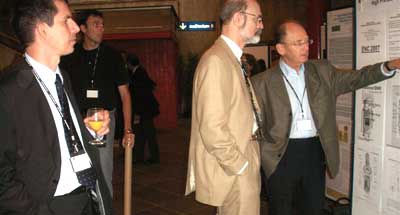
Some four hundred Boiling Water Reactors (BWR) and Pressurized Water Reactors (PWR) have been in operation for several decades. The present concept, the High Pressure Boiling Water Reactor (HP-BWR), makes use of this operating experience. The best parts of the two reactor types are used and the troublesome components are left out. This means improved safety. The increased thermal efficiency is beneficial to the environment as less cooling water is released per produced kWh. With some modifications the used components can be used to make this design cost effective and possible to achieve in the currently not too distant future.
Since the 1950s several hundred Boiling Water and Pressurized Water Reactors (BWRs and PWRs) in use. There is a wealth of operating experience. During this have been time many difficulties occurred with a number of important components. This concept, the High Pressure – Boiling Water Reactor (HP-BWR) offers a solution to use the best parts from each type (BWR and PWR) and leave out the troublesome components. This means an important increase of safety. As an extra benefit, also increased efficiency attained beneficial for the environment as less cooling water is released per produced kWh. The HP-BWR is using –with some modifications- currently manufactured parts making this a cost effective, realistic concept.
The High Pressure Boiling Water Reactor (HP-BWR) offers improved nuclear safety and less damage to the environment. The HP-BWR is an environmentally friendly, effective alternative.
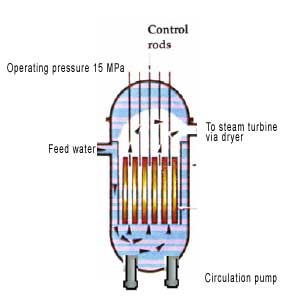
The HP-BWR uses a modified PWR reactor vessel and BWR type fuel and control rods. However, here the cruciform control rods are gravity operated with ample space between the crosses and the fuel boxes. The control roads are manoeuvred electromagnetically, which means that they will drop into the core when there is a loss of electrical power as in the PWRs. The traditional PWR control rods are finger shaped and are surrounded by a tube with a minimum of clearance. The traditional BWR control rods are operated from below with hydraulic pressure. Therefore, at the bottom of the traditional BWR reactor vessel there are a great number of penetration points for the control rods. Directly below the reactor vessel there is an elaborate system of numerous high pressure hydraulic pipes to actuate the control rods. Taking the best fro and leaving out the drawbacks of both the traditional BWR and PWR systems is a substantial safety improvement.
All the pipe connections to the reactor vessel are well above the reactor core. This allows the omission of core spray. The moisture separators and steam dryers are outside the reactor vessel, leaving free space for the control rods.
Internal circulation pumps. These allow the use of orifices at the inlet of the fuel boxes so that the one-phase pressure drop will predominate over the two-phase pressure drop. This reduces the risk of hydrodynamic oscillations. However, if suitable methods are found to facilitate natural circulation even the circulation pumps can be left out.
The use of the HP-BWR means improved Carnot cycle thermal efficiency up to about ~40% instead of about ~30%. The reason is that the HP-BWR steam temperature corresponds to 15MPa while the traditional BWR’s steam temperature corresponds to 7MPa and the traditional PWR’s steam temperature corresponds to 6MPa. The HP-BWR is lenient to the environment as less damaging cooling water is released per produced kWh to the recipient, sea or river or to the air via a cooling tower.
Using direct cycle the system is simplified. Still, the usual PWR steam lines can be used through the containment wall to the turbine. A great advantage is that the complicated and costly steam generators are left out.
The moisture separators and the steam dryers are outside the reactor vessel in the containment instead of the huge troublesome steam generators.
Simple dry containment is used instead of the complicated, inert, pressure suppression wet containment which requires a great deal of surveillance.
The basic principles of the traditional Boiling Water reactor are well known
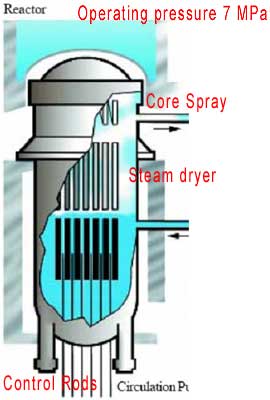
As there are pipe connections to the reactor vessel below the reactor core, a pipe break can empty the vessel leaving the core uncovered, without the cooling water. Therefore, a core spray is required. This is a common feature for the BWRs with external circulation pumps or jet pumps. However, this draw back is eliminated at a later design stage with the Advanced Boiling Water Reactor, ABWR. All BWR control rods are inserted to the core using hydraulic power; some with electric motors too. This makes the lower part of the rector both inside and outside the bottom of the reactor vessel extremely elaborate. To make things worse, in the past, cracks, corrosion and leakage occurred at the penetrations at the lower part of the reactor vessel.
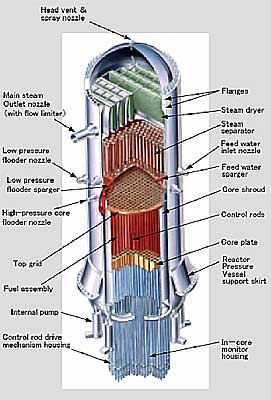
Traditional Advanced Boiling Water Reactor (Hitachi–ABWR)
The huge reactor vessel would require an enormous dry containment building. Therefore, a pressure suppression containment system is used instead. The containment is separated into two parts, the upper dry well and the lower wet well with the suppression pool. If the separation is not perfectly leak-tight the wet well cannot fulfil its function to suppress the pressure in the dry well in case of a pipe break. Further complication is that the traditional BWR containment operates inertly, making difficult the entrance into it.
The nice thing about the BWR is that it operates in direct cycle mode without the troublesome steam generators.
Most of the world’s operating reactors are traditional PWRs.
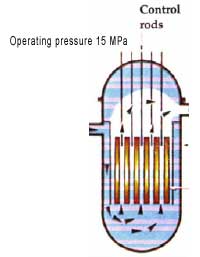
The control rods are operated from above. Undoubtedly some leakages were observed at the penetrations which in a few cases led to the need to replace the reactor pressure vessel head.
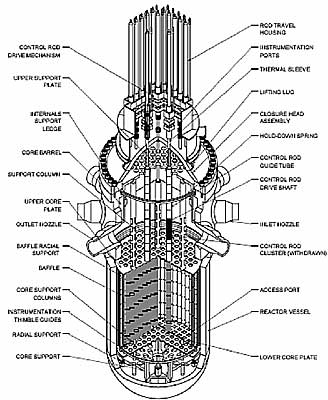
The simple electromagnetic devices which manoeuvre the rods worked reliably. This assures a high degree of safety. A basically continuous, uninterrupted bottom of the reactor vessel avoids any suspicions of its integrity.
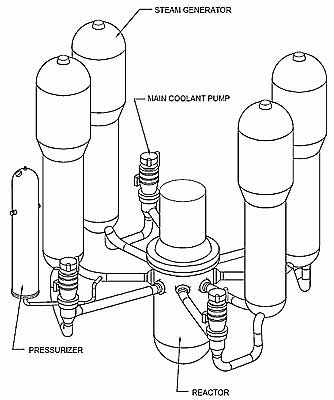
A four-loop Westighouse plant has four steam generators, four reactor coolant pumps, and a pressurizer. The four-loop units in the United States are Braidwood 1 and 2, Byron 1 and 2, Callaway, Catawba 1 and 2, Comanche Peak 1 and 2, D.C. Cook 1 and 2, Diablo Canyon 1 and 2, Indian Point 2 and 3, McGuire 1 and 2, Millestone 3, Salem 1 and 2, Seabrook, Sequoyah 1 and 2, South Texas Project 1 and 2, Vogtle 1 and 2, Watts Bar 1, and Wolf Creek. Each of these plants has 193 fuel assemblies arranged inside a reactor vessel that has an internal diameter of 173 inches (except South Texas has an internal diameter of 167 inches). The fuel assemblies are arranged in 17 x 17 array except for Cook and Indian Point, which have 15 x 15 fuel. The electrical output of these plants ranges from 950 to 1250 megawatts.
The curse of the traditional PWRs is their steam generators. These complicated and costly huge pieces of equipment are disappointingly short lived because of the corrosion of the internal tubes, which can cause leaks. The plant owners used to change them after some fifteen years. An extremely expensive and troublesome and also time consuming operation.
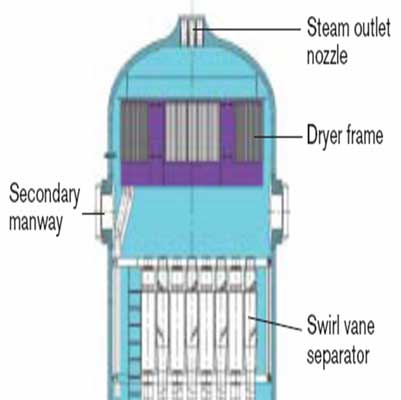
In the upper part of the steam generators there is the moisture separator and the steam dryer. The HP-BWR is “borrowing” this equipment which can be used without the troublesome steam generators.
All university text books written for nuclear engineering students contain detailed descriptions of both Boiling Water Reactors and Pressurized Water Reactors. Also manufacturers in Europe, Asia and America publish data about their designs. There is also a wealth of information about BWRs and PWRs on the internet.
http://www.euronuclear.org/e-news/e-news-18/austria.htm


Otmar Promper, Helmuth Böck
Technische Universität Wien
Stadionallee 2, A-1020 Wien, Austria
otmar.promper@gmx.de, boeck@ati.ac.at
One of the biggest challenges in the future of the Austrian power sector is the reduction of greenhouse gas emissions as Austria agreed in Kyoto to reduce greenhouse gas emissions by 13% compared to 1990 levels. Due to increasing electricity demand, there is a need to build new power plants in the future. Today, the use of nuclear power for electricity production in Austria is prohibited by law. The aim of this paper is to analyse the future of the Austrian power sector concerning greenhouse gas emissions and guarantee of supply. Various scenarios taking the above conditions and different technologies into account are calculated. The investigated technologies include fossil fuels, renewables and nuclear power. The aim is to analyse the impact of the different scenarios on greenhouse gas emissions and supply security.
Electricity demand, green house gas emissions, CO2, nuclear energy, fossil fuels, supply security.
In the mid-sixties Austrian energy planning proposed up to five NPPs by end of the 20th century in order to fulfil the country’s electricity demand. The decision in Austria to build the first nuclear power plant (a 723 MWe BWR by AEG/KWU) was taken in 1971 by the Gemeinschaftskernkraftwerk Tullnerfeld GmbH, a state owned power company, The location of the power station was Zwentendorf , 60 km northwest of Vienna, on the river Danube. Construction started in 1972 and it was scheduled to start operation in summer of 1976. After two years of delay in construction the plant was nearly finished in 1978 and was scheduled to start operation in fall. Two years before, in 1976, a very intensive public and political discussion about using nuclear power for electricity production started. Based on this discussion the Austrian government carried out a referendum about using nuclear power. On November the 5th, 1978 the Austrian voted with 50.47% against the use of nuclear power for electricity production in Austria. Since this time the use of nuclear power for electricity production in Austria has been prohibited by law.
Instead of the nuclear power plant two coal fired plants were built. But in the last 25 years many energy aspects changed and today there are totally new challenges in the power sector.
Austria generates most of its electrical energy from hydro power. In 2005 the share of hydro power (river and storage stations) was 57%. 33% were generated from thermal power, 6% from renewables including all bio-energy sources like waste and clearing sludge, 0.2% from others and 4% was from net imports (Fig. 1).
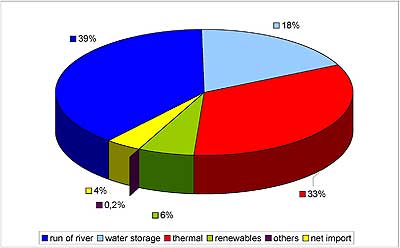
Figure 1: Electricity production in Austria by source 2005
(source: own calculation, [1])
In the early 90s the share of hydro power was nearly 70%. As a reason of this increasing electricity demand, which has increased by more than 2% per year in the last ten years (see fig. 2), the share of hydropower dropped down to 57% and thermal power increased up to 33%. Austria also changed from being a net exporter of electricity to being a net importer since 2001.
Figure 2 shows also three projections of the possible demand for electricity in the next twenty five years. The projection reached from a low scenario with an increase of only 1.5%, a reference scenario with an increase of 2% and a high scenario with an increase of 2.5% per year [2].
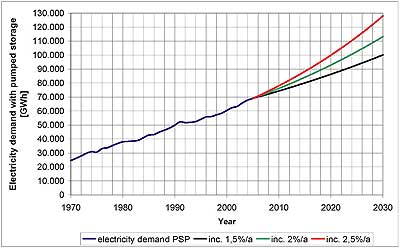
Figure 2: Electricity demand in the past and projection in the future
(source: own calculation, [1])
The potential of hydropower is already used by up to more than 70% and there
is no possibility for a further increase in this sector. To close the gap
between production and demand which will be up to 18,7 TWh in 2021 and 38,6
TWh in 2030, Austria has three options left:
Thermal power with fossil fuels
Increasing electricity import
Nuclear power
Renewable energy sources which are mainly favoured by politicians and media are no option, as their potential in Austria is so small that no major electricity production can be expected except in very local conditions. In adition to wind and solar energy sources reliable back-up energy (either fossil, hydro or nuclear) is necessary to compensate for outage periods.
Increasing the thermal production raises two problems for the power sector.
Austria has only few reserves of fossil fuels. 80% of natural gas and 100% of coal have to be imported.
Increasing thermal electricity production means increasing green house gas emissions
Electricity imports increase strongly Austria’s dependence from abroad. An additional technical problem with the grid and it simply transfers the green house gas emissions problem with abroad
Therefore, the only option is to use nuclear power. Nuclear power can produce the required amount of electricity, has very low green house gas emissions and the fuel amount for several years can be easily stored on site.
The motivation for this paper and is to analyse whether the prohibition of nuclear power for electricity production in Austria is still up to date with respect tp developments since the referendum in 1978. Politicians should not only have their re-election in mind thus following the opinion of the blue-press but they have also the responsibility to ensure a secure and environmental friendly energy policy in future. Therefore, they should initiate a change in nuclear policy to meet the new challenges of the power sector in the future.
To illustrate the impact of different options for future electricity supply on CO2- emissions and supply security of several scenarios were developed and different technologies compared. In this case it is not necessary to calculate the absolute values (of e.g. greenhouse gas emissions) exactly but just to compare two different technologies. Therefore this method is very appropriate for such scenario analyses.
The approach in the models is to build virtual new power
plants with different technologies and primary energy sources over the period
of consideration. The aim of each model is to cover the electricity demand
with a range of fluctuation of ![]() 5%.
5%.
Three scenarios with at least 25 technologies paths were analysed in this work. The period under consideration reaches from 2005 up to 2030. The main scenarios differ in the growing of electricity demand. The details of the analysed scenarios are described below:
Scenario A0 (referenze scenario)/A1
Electricity demand is growing by 2% per year.
Higher utilization of large existing thermal plants then 2005 in A0.
Utilization of large existing plants like 2005 in A1.
Scenario B0/B1
Eelectricity demand in growing by 1.5% per year.
Higher utilization of large existing thermal plants then 2005 in B0.
Utilization of existing plants like 2005 in B1.
Scenario C0/C1
Growing of electricity demand 1.5% per year.
Higher utilization of large existing thermal plants then 2005 in C0.
Shutting down all large existing thermal plants in 2015 before the end of their lifetime.
C11, C12- two scenarios with a lower increase in electricity demand of 1% and 0.5% per year.
The technologies used in the models are listed in Table 1. The primary energy sources in this table are the only realistic ones which can be used in Austria in the future. The efficiency of each technology depends on state-of-the-art at initial construction.
With these technologies the following power plant paths in each scenario were created and analysed.
GTCC with natural gas
CCT plus hard coal (pulverized)
Nuclear power
Nuclear power plus hard coal (pulverized)
GTCC plus Clean coal technology
All technologies, except nuclear power plants, have the same utilization in the model of 6500h per year, while nuclear power plants have a higher utilization of 7500h per year because of their special aptitude for base load.
There are some boundary conditions for the scenario calculations which are valid for all models.
The production of hydropower is constant with 40 TWh per year over the period under consideration.
Renewable energy sources will increase to a share of 10% of electricity production by 2015. From 2015 to 2030 the share of renewables will stay constant between 10% and 12% of total production. Actually this is a very optimistic value [3].
All large (PN > 100MWel) thermal plants will be shut down after a lifetime of 35 years [2].
Considered are only power plants to satisfy the demand without any reserve capacity and given utilization.
All assumptions are conservative. This means e.g. minimal number of power plants, no reserves, best efficiency.
Technology |
Power [MWel] |
Fuel |
Efficiency |
pulvericed coal |
750 |
hard coal |
48%, 50%, 52% |
CCT |
750 |
hard coal |
40%, 45% |
GTCC |
400 |
gas |
60%, 65% |
GTCC |
850 |
gas |
60%, 65% |
LWR |
1200 |
UO2 |
35% |
LWR |
1600 |
UO2 |
35% |
Table 1: Used technologies for new power plants in the models
As it is not possible to show the results of all scenarios and power plant paths within this paper only the most important results, mainly the nuclear scenarios, are presented here.
Figure 3 shows the results of the power generation mix up to 2030 in the nuclear scenario A02 by fuel. The demand including electricity for pump storage will rise from 57584GWh in 2005 up to 92620GWh in 2030. In this scenario there two GTCC plants are considered, which are actually already under construction and operational in 2008 and 2009. In 2018 the first nuclear plant with 1200MWel will start operation and in 2030 three nuclear power plants with at least 3600MWel will be in operation.
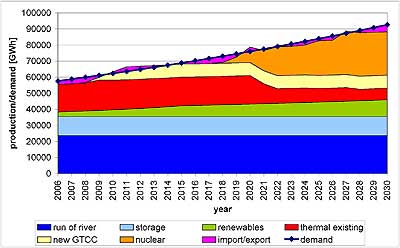
Figure 3: Nuclear scenario A03, increase of demand by 2% per year (source:
own calculation)
The share of nuclear power in electricity production will be 12% in 2020 and 29% in 2030. Hydropower has a share in 2030 of 38%, renewables 11%, existing thermal plants 8%, new GTCC 9% and import 5%.
Figure 4 shows the same picture as in the scenario A03. The main difference is the increasing electricity demand, which is only 1.5% in B03. It starts also from 57584GWh in 2005 and reaches 82316GWh in 2030. As a reason of the lower demand the first nuclear power plant with 1200 MWel start operation not before 2019. In 2030 there are at least two nuclear power plants in operation with together 2400 MWel. The share in electricity production of nuclear power in 2030 will be 21%, hydropower 43%, renewables 11%, existing thermal plants 9%, 10% new GTCC and 6% import.
Compared to the two nuclear scenarios Figure 5 shows the generation mix of the GTCC scenario A01 with an increase of demand of 2% per year.
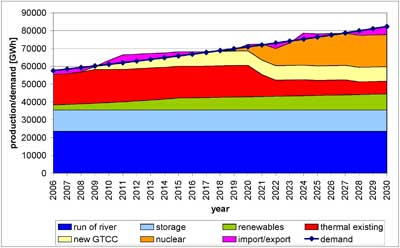
Figure 4: Nuclear scenario B03, increasing of demand 1.5% per year
(source: own calculation)
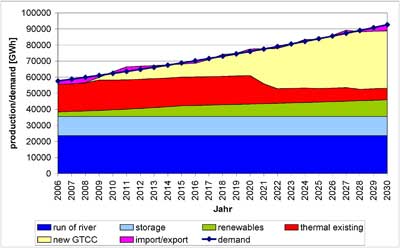
Figure 5: Natural gas scenario A01, increasing of demand 2% per year
(source: own calculation)
In this scenario all new built power plants use GTCC technology. The generation mix in 2030 consists of 39% new GTCC, 38% hydro, 11% renewable, 8% existing thermal plants and 4% import. A big share (47%) of Austria’s electricity production in 2030 will depend on natural gas because all existing thermal plants at this time use also natural gas as a fuel.
In conclusion it can be stated, that Austria’s electricity production in the future will depend more and more on thermal production either with fossil or nuclear fuels. The share of hydropower will decrease in all scenarios from now 57% to below 45%. Even if the increase in demand is reduced down to 1% or even 0.5% the share of hydropower will be 45% until 50% respectively.
New power plant capacity will be required with at least 2400 MWel or even up to 4600 MWel depending on the selected scenario. These are minimum values because of the assumed high utilization factor of new plants in the calculations. Considering reserve capacity and lower utilization the values of the required new capacity will be much higher.
Increasing the production of thermal plants with fossil fuels, means also an increase in fuel demand. As mentioned before Austria has very little reserves on fossil fuels. Only 19.7% of the demand of natural gas is produced in Austria. Most of the natural gas in Austria comes from Russia (58.6%), Germany (12.6%) and from Norway (9.1%) [1]. Also the total demand of hard coal has to be imported, mainly from Poland and Czech Republic (88%). Austria also has no reserves of lignite leel. Moreover, lignite has a very low calorific value and high specific CO2-emission. These are the reasons why lignite has not been taken into account for thermal plants in Austria.
Figure 6 shows the evolution of the natural gas consumption in the reference scenario A0. The values are based on 2005. In the GTCC scenario A01 the increase is as expected very strong. It will nearly triple from 3.6 Gm3 to 9.66 Gm3 per year until 2030. In the scenarios A02 with hard coal and A05 with clean coal technologies, where also GTCC technology is used, the increase is not so strong. In A02 the consumption will nearly double to 6.6 Gm3 and in A05 to 6.27 Gm3. In the nuclear scenarios A03 and A04 the consumption of natural gas will shortly increase until 2011 and then drop back to the values of 2005 until 2030.
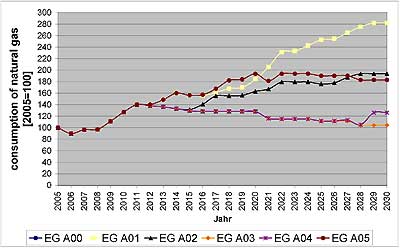
Figure 6: Evolution of the natural gas consumption in Austria up to 2030 (source:
own calculation)

Figure 7: Evolution of the hard coal consumption in Austria up to 2030 (source:
own calculation)
In Figure 7 the consumption of (hard coal) in the reference scenario A0 is
shown. As expected the increase of consumption in the coal scenarios A02
and A05 will be the strongest.
In A05 with clean coal technology the consumption will nearly quadruple, from 1.65 Mt to 6.2 Mt per year in 2030. In A02 it will increase up to 5 Mt in 2030. In the nuclear scenario A03 and in the GTCC scenario A01 the consumption will drop to zero after shutting down the existing plants fired with hard coal in 2021. In the scenario A04 with nuclear power and one new hard coal fired plant the consumption will drop down to 80% of 2005.
The consumption of fossil fuels in the other scenarios (B,C) is equal or slightly lower. It is obvious that more thermal plants (whether natural gas or hard coal fired) will increase the dependence in primary energy supply significantly in the future. The mass flow rates of fossil fuels in the future will, therefore, be very high. This has a negative effect on the security of supply in Austria’s power sector.
For nuclear power plants the consumption is only a few hundred tons of natural uranium per year. Uranium is also a wide spread all over the world and in stable political regions. Thus uranium has two advantages compared to natural gas and hard coal in Austria:
The mass flow rate of uranium is much lower.
The storage possibility of uranium fuel even for several years is very simple and needs little space
Another important point is the evolution of the green house gas emissions in Austria’s power sector. Austria signed the Kyoto Protocol and committe to reducing green house gas emissions (mainly CO2-emissions) to 13% based on 1990 level. The base for the CO2-emissions in 1990 of the power sector is 10.89 Mt and Austria’s commitment is to reduce these emissions to 9.47 Mt until 2012. The share of the power sector of the totally CO2-emissions in Austria is 14%.
Figure 8 shows the evolution of the CO2-emissions in the reference scenario A0. The magenta line is the base of 1990 and the green line the aim of the reduction (9.47Mt). The strongest increase is in the hard coal scenario A02. The emissions in this scenario will more then double from 11.3 Mt in 2005 to 23 Mt in 2030. There is also a strong increase in the GTCC scenario A01. The CO2-emissions in this scenario will increase up to 16.2 Mt in 2030. In the clean coal and nuclear coal scenarios A05 and A04 the emissions will increase until 2021 by up to 13.15 Mt. After shutting down the existing coal fired thermal plants the CO2-emissions will drop down to the level of 1990. Only in the nuclear scenario will the emissions drop down below the level of the Kyoto target. The emissions in this scenario are 6.1 Mt in 2030.
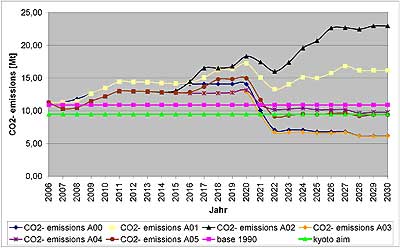
Figure 8: Evolution of the CO2-emissions in Austria up to 2030
(source: own calculation)
The other scenarios show similar values of CO2-emissions. In the scenario B with lower increase in demand the CO2-emissions are also lower, but nevertheless they are above the base of 1990 and the Kyoto target (except nuclear scenario B03/B13). Concluding this section, the CO2-emissions in the power sector will increase in all scenarios except in the nuclear and energy saving scenario.
In summary, the analysis has shown that there is a great requirement for new power plant capacity in the future in Austria, to satisfy increasing electricity demand. Another result of the analysis is that the future of the Austrian power sector leads either to thermal production or to increased imports. Hydropower and renewables have very little potential to satisfy future electricity demand. Direct import of electricity leads straight to dependence on foreign imports for electricity supply, because there is no possibility to store electricity in big quantities.
Concerning the thermal production, the only two options are fossil fuels or nuclear power. As shown above nuclear power can fulfil all the requirements to satisfy the future electricity demand both in view of security of supply and reduction of CO2-emissions.
The need for fossil fuels like natural gas or hard coal will increase in all scenarios (except nuclear) and, therefore, primary energy imports will too. It is difficult and expensive to store natural gas in big quantities. So the excessive increase in gas consumption will also lead in strong dependence of foreign countries and has therefore negative effects on guarantee of supply. Concerning CO2-emissions the nuclear scenarios are the only one which can fulfil the Kyoto aims of Austria. In all fossil scenarios the CO2-emissions will more than double according to the Kyoto aims. There is only one non nuclear scenario which can reach the Kyoto aims if the increase of electricity demand is reduced to about 0.5% per year.
If Austria wants to continue to act as a model state of clean environment in Central Europe it should reverse its anti-nuclear policy to meet the future challenges in the power sector.
[1] E-Control GmbH, www.e-control.at.
[2] G. Brauner, “Entwicklung der österreichischen Erzeugungskapazitäten bis 2015“, Int. Energiewirtschaftliche Tagung IEWT), Vienna 2005.
[3] R. Haas, “Perspektiven der österreichischen Stromversorgung im liberalisierten Strommarkt“, Int. Energiewirtschaftliche Tagung IEWT), Vienna 2005.
[4] S. Böhmer et al., “Stand der Technik bei kalorischen Kraftwerken und Referenzanlagen in Österreich“, Umweltbundesamt, Wien 2003.
[5] K. Kugeler, P. W. Philippen, Energietechnik, Springer, Berlin, 1990.
http://www.euronuclear.org/e-news/e-news-18/cea.htm

The Commissariat à l’énergie atomique (CEA), the French Atomic Energy Commission, recently signed a declaration signalling its intent to adopt the European Commission’s European Charter for Researchers and Code of Conduct for the Recruitment of Researchers. This adherence was specially officialized during the SNETP (Sustainable Nuclear Energy Technology Platform) launching where the EU Science and Research Commissioner, Janez Potocnik, EU Energy Commissioner, Andris Piebalgs, senior CEA representatives, EC officials and some journalists were present. In a nutshell, the European Charter is a series of general principles and basic conditions that define the roles, responsibilities and prerogatives of researchers, their employers and those who fund research.
By signing up to the Charter and Code of Conduct the CEA has underlined how important it believes it is to strengthen the attractiveness of the EU as a breeding ground for research excellence and an arena for committed and talented researchers to opt for an interesting and fulfilling career in research. Adherence to the Charter also underlines the CEA’s commitment to promoting increased mobility for Europe’s researchers and spotlights the emphasis that the CEA gives to human resources policies and procedures that seek to encourage the hiring, education and training of researchers, especially with regards to the nuclear domain. On this question, Commissioner Potocnik stressed the importance that the European Commission also attaches to optimising working conditions and career prospects for researches when he said: “Creating a research-oriented Europe depends upon improving researchers’ working conditions. It is essential that research institutes commit themselves to providing researchers with the best possible career opportunities.”
This view was echoed by Alain Bugat, the CEO of CEA, who also linked improved working conditions to encouraging competitiveness: ”The CEA is convinced that the ability of research institutes to offer attractive working conditions and career opportunities to researchers is a key factor in meeting the challenge of maintaining Europe’s scientific and economic competitiveness.”
The CEA has already put the majority of the Charter’s recommendations into practice. For example, in order to encourage researcher mobility it has written new specific fixed- term employment contracts, compatible with EU employment legislation, that enable French and foreign researchers to work on research projects under the aegis of the EU’s 6th and 7th Framework Programmes.
Furthermore, by signing up to the Charter and the Code of Conduct the CEA has reaffirmed the active role that it plays – and intends to continue playing – in promoting the European Research Area, in maintaining Europe’s position as a world leader in scientific excellence and in ensuring that Europe’s industry remains highly competitive. Only by recruiting and retaining the best researchers can the technical advances identified ensure the sustainability of nuclear research.
For more information about the European Charter for Researchers and Code of Conduct for the Recruitment of Researchers consult the CEA’s website at: www.cea.fr.
http://www.euronuclear.org/e-news/e-news-18/croatia.htm

International conference Nuclear Option in Countries with Small and Medium Electricity Grids has established itself as a traditional meeting place for discussing various key issues related to the use and development of nuclear energy on a genuinely international level. After a decade of being successfully organised in Dubrovnik, the conference has benefited from its long-standing association with co-organiser the IAEA and has ENS as a major sponsor. Although the conference will focus primarily on a range of issues affecting countries with limited grid size and their specific needs, the topics on the conference agenda cover a number of subjects of fundamental interest to professionals in the nuclear and energy sectors, more specifically those related to using the nuclear option to generate electrical energy. With this aim in mind the conference will consider the nuclear option from its position as one of the major energy sources available for helping to reduce CO2 emissions, analyse the market situation of nuclear energy, focus on the development of new reactor technologies and assess the organisational, educational and social needs for using nuclear energy to generate electricity.
True to conference tradition, next year’s event will also serve as a forum for discussing the various major issues linked to the operation and safety of the nuclear power plants, nuclear liability, regulatory practices and radioactive waste management.
For the additional information please visit the conference
web site at:
www.cro-nuclear.hr/Dubrovnik2008
http://www.euronuclear.org/e-news/e-news-18/icem.htm

The BNES YGN was recently given the chance to present at the 11th International Conference on Environmental Remediation and Radioactiove Waste Management (ICEM 07), which was held, in Bruges, from 2-6 September. The YGN were invited to host 2 sessions, the first relating to workforce issues and training programmes and the second a panel session where we invited Jean Llewellyn, Project Director for the National Skills Academy for Nuclear, to join us and lead the debate about challenges facing the YGN. Both sessions were hosted by our YGN Chair Neil Crewdson and Vice Chair Linda McLean. The sessions were very positive, with all speakers leading a debate into the difficulties that we are facing and offering their perspectives on how we are responding to the change in demand for skills as we engage the current nuclear renaissance.
The first presentation was by George Reeves. He discussed the first 2 years in operation of DERC – a centre for decommissioning and environmental remediation in the highlands of Scotland and the problems he faces securing funding and places for future applicants. Sarah Greenwood from RM Consultants next explained how she has developed a programme to spot talent in graduates and support them through their career development until they become qualified and successful consultants. The Dalton Institute was represented by Warren Richards who discussed how industry, government and research councils are taking steps to reverse the 20 year trend of underinvestment that has led to the current skills shortage. He then focused on several programmes such as the development of the Dalton Institute and the national laboratory. Ogla Batyukhnova of Russia added an international dimension to the session by telling us about the last 10 years of the Moscow SIA Radon international education training centre and how they use several methods, including socio-psychological aspects, when assessing the efficiency of their training programmes aimed at ensuring that they can continuously improve training methods.
My presentation focused on graduates and how they are being developed in the UK. It focused on the highs and lows of graduate training and how the YGN and the NDA are focusing on improving graduate programmes to recruit and retain the best graduates into the industry.
The panel session kicked off with an introduction from Jean Llewellyn, which lead to a lively debate on the challenges the industry is facing due to the shortage of skills. The audience quickly joined in and Richard Mrowicki from the NDA answered some difficult questions relating to the NDA programme and how it was effecting the development and training programmes offered by some companies. Over all, the event was very forward-looking. The key messages that emerged from the conference were that we must work together to address the skills shortage and ensure that the nuclear industry is made more attractive for graduates and their career development.
For more information on the conference consult the ICEM 07 web site at: www.icemconf.com
Whilst the ICEM conference was going on a technical tour of France was also taking place. The tour was organised by Ben Salisbury of British Energy and the BNES YGN and hosted by AREVA and ENS.
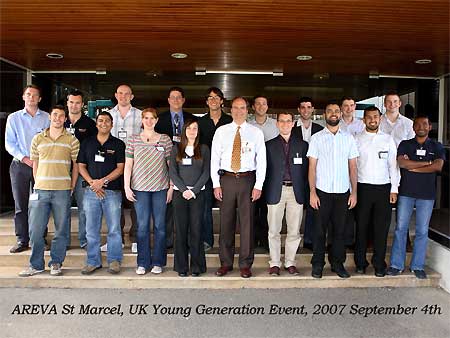
The tour was attended by 17 BNES YGN members representing a variety of nuclear backgrounds. Starting in Marcoule, in the south of France, the tour travelled north to Flamanville, in Normandy, following the closed nuclear fuel cycle that Areva NC operates. This incorporated the reprocessing and recycling of plutonium and uranium for use in “MOX” fuel, as well as the segregation, treatment and disposal of used fuel elements and radioactive waste. The tour also included visits to the steel forge and metalworking plants which produce plant components. Finally an operating light water reactor was visited along with the building site of one of the world’s two new European pressurized reactors (EPRs).
The following is an extract from the full visit report, which can be found on the YGN website.
‘On Monday the tour started in Marcoule, Gard Region where we visited the Phénix, France’s second prototype Fast Neutron Reactor (FNR). The reactor is a research facility which can be configured to “breed” plutonium from fission in uranium 238, thereby increasing the amount of energy produced from natural uranium by 50%. Alternatively, the reactor can be used to “burn” radioactive waste and transmute long-lived fission products and actinides into stable elements or radioactive products with reduced half-lives. This process, if extended to a commercial scale, could reduce the nuclear waste legacy for future generations.
We also visited the Melox plant, which was on the same site, this plant takes plutonium and uranium oxide from Areva’s facilities at La Hague. These materials are mixed to the correct enrichment level for a particular fuel assembly.
The theme for Tuesday’s visit was the construction of the major steel assemblies used in nuclear power plants. The first location we visited was the Creusot forge plant belonging to the Sfar Steel Group. This forge is capable of producing very large forged steel components, some of them weighing up to 360 tons. During the tour a 150 ton ingot of steel was lifted out of one of the gas furnaces glowing red, placed into the 7500 ton press and had a 10 ton section sliced off. This activity made quite an impression on everyone. |
 |
Located deep in rural south-eastern France is the Andra waste disposal repository, final destination for 90% of Frances radioactive waste, was the destination on Wednesday. This site was especially chosen on account of the geological make-up of the environment. The intermediate and low-level waste (ILW & LLW) that is handled and stored at the facility is not just put into drums; complete pressure vessel heads are put in place. The group also visited a second site which handles very low-level waste (VLLW) and learned about the differences between British and French disposal methods.
|
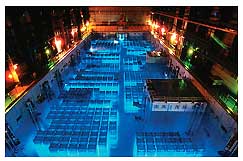 |
around 6,000 people it extends underground and all of the processing is remotely controlled to limit employee exposure.
The final stop on the tour was Flamanville, with its two EDF PWR reactors with a capacity of 1300MW each. These stations, although impressive, were not as interesting as the construction site next to them. In this site the foundations of the new Flamanville 3 EPR station have been laid. However, at this early stage all that could be seen were some basement sections and the bottom of the containment area. The site physically looks larger than the sister stations. This is intentional in order to provide 4 levels of system redundancy, increased lay down areas that enable easier maintenance and an increased power output of 1600MW. From the outset the EPR design is MOX adapted and builds upon the operating and construction experience obtained from the 93 other PWRs that Areva has built.
Standing there and looking at the framework of the new EPR under construction you were struck by the realisation that the future was unfolding before you. A closed fuel cycle with minimised volumes and toxicities of radioactive waste coupled to effective reprocessing and recycling of uranium and plutonium to reduce demand on world resources. And all this supporting a technology that is proven, safe, reproducible, low carbon, cost effective and currently supplying 80% of Frances energy needs. It certainly looks like a good model to work from.
Steven Wootten (British Energy)
http://www.euronuclear.org/e-news/e-news-18/bnes.htm

The BNES/INucE Congress 2007 took place at the University of Manchester from 19 -21 June. The theme of the congress was Building a Future for Nuclear and over a busy three days an impressive array of presenters from the UK and abroad highlighted the challenges facing our industry and the opportunities for ensuring its success.
The YGN was invited to assist with the running the event and a motivated team of volunteers arrived in Manchester on the eve of the Congress to plan for the days ahead and prepare hundreds of delegate packs for distribution the next morning. Despite the odd minor panic behind the scenes the event ran pretty smoothly thanks to the team’s combined efforts. The volunteers took the opportunity to attend as many presentations as possible, running microphones for question times and taking notes on each of the sessions. YGN Chair and Vice Chair, Neil Crewdson and Linda McLean respectively, had the unenviable task of collating the notes and presenting summaries of the previous days’ events at the beginning of days 2 and 3 of the congress, which they did with confidence and professionalism. It was an excellent way to raise the profile of the YGN.
The Congress sessions were grouped under the headings of New Build, Clean Up, Stakeholders, Waste Management, Operations and People. However, many of the issues discussed throughout the event proved to be of common interest to all sectors of the industry. In particular, the skills shortage faced by the nuclear industry, both at home and internationally, was a commonly expressed concern. Positive steps were being made to address this in the UK, with the establishment of the Dalton Institute and the National Skills Academy for Nuclear, and with a consortium of Universities now offering nuclear engineering degrees. However, it was noted that these steps can only become fully successful if we also address the skills issue at the grass roots level. In other words we need to encourage the study of science and maths in school rather than watch the continued decline in these subjects. We then must attract young people with talent in these areas to study science and engineering at university and, further still, attract them into the nuclear industry rather than losing them to other more lucrative careers, for example, jobs the financial sector. The challenge is substantial but we can all contribute to meeting it, as organisations and as individuals, by working to raise the profile and improve the public perception of the nuclear industry.
As young people making their way in the industry, many YGN members were most interested to learn about the prospect of new nuclear build in the UK. Aware as we are that the decommissioning and clean up side of the industry will provide wide-ranging and challenging opportunities for years to come, we nonetheless couldn’t help being slightly more excited by the prospect of new nuclear power stations being commissioned and operated in the UK. Such a prospect inspires us, and also the scientists and engineers of the future, to view our industry as one on the up rather than in decline.
Those of us within the industry are well aware of the arguments for new build. Recent political, environmental and economic issues have led to revived Government support for nuclear new build. Public attitudes, though divided, are slowly becoming more positive towards the idea. There seems to be a consensus between vendors, operators and regulators on the way forward with the licensing of new stations, all keen to avoid long delays and learn form past experiences. The standardisation of design would certainly be an advantage in speeding up the process, and would allow us in the UK to benefit from sharing ideas and experiences with the international nuclear community.
In summary, the BNES/INucE Congress 2007 was an informative and encouraging
three days. YGN members left feeling far more aware of the issues facing
our industry, and encouraged by the opportunities that its future present
us with. The presentations, exhibition stands, workshops, and of course the
conference dinner held at the Imperial War Museum, provided valuable opportunities
to converse with others representing all areas of the industry. The trend
in today’s nuclear industry for alliances and cooperation between companies
reflects our own ethos at the YGN and we look forward to playing our part
in building a future for the UK nuclear industry.
Marianne Wilson - Jacobs
During the BNES/INucE Congress 2007 two YGN break out workshop sessions were held. These were organised and run by Sam Henson of the YGN and British Energy and were well attended by YGN members and many other Congress delegates. The key objective of these sessions was to debate the skills shortage issues and produce a set of actions that could be fed back to the Congress in a 15 minute presentation.
Two problem statements were defined as follows:
“There are difficulties in teaching and presenting the nuclear industry to 14 to 19 year olds”.
While the second begun as a ‘devil’s advocate’ “Alternative solutions are needed to meet the nuclear industry’s skills gap”.
Considerable background work was carried out to put together the problem statements. For the first problem statement Alex Wilcox, a graduate from British Energy, conducted a detailed survey of schools in the Lancashire area to find out quantitatively how much local teenagers knew about nuclear power and what their opinions |
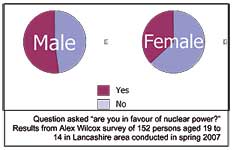 |
were. Summaries of these results can be seen in the diagram (see right) and more can be provided upon request. Qualitative comments from the results were also a good indication of how severe the problem of poor teenagers’ understanding of nuclear power really is. The best reaction to summarise this is: “nuclear power is dangerous because it gives out lots of nasty gases”.
To address both problem statements the group was split into
two teams who were assigned the task of addressing one of the problem statements.
Frank Cronin of AMEC Nuclear proved to be a highly energetic, efficient organiser
and helped to guide both groups from the initial problem statement through
identifying root causes, suggesting mitigation solutions and finally producing
an implementation plan for the solutions. His suggestion of using the Ishikawa
method and bringing it into the workshops helped make excellent use of time,
producing some very interesting results. With all this information collected
the groups shared the results of their respective work in order to get some
comments.
The reasons for the views expressed by the 14 to 19-year olds were identified
as:
Education – poor perception and the limitations of the school curriculum
Industry – not positively or effectively representing its views
Media – sensationalist press supporting the view that nuclear seen is highly dangerous
The main countermeasures identified for addressing this problem statement were to input the positive aspects of the nuclear fuel cycle into the national curriculum and to hire a National Schools Liaison Officer.
Finding alternative solutions provided a very heated debate, particularly when it came to outsourcing large projects to overseas companies. The most significant countermeasure proposed was to set up a joint industry-wide campaign to attract new graduates and people who have left the industry. Bearing in mind that mitigation and implementation plans for both problem statements were fairly similar and suggested that the majority of required activities are all ready being carried out, they are just not sufficiently high profile.
Finally, the results and details of the workshop were included in a presentation that I delivered to Congress delegates. The presentation lasted approximately 15 minutes and was well received. It was an excellent experience for me and I would like to thank all who were involved.
Sam Henson - British Energy
http://www.euronuclear.org/e-news/e-news-18/boreal-nights.htm


The idea of privileged exchanges between the French and the Russian Young generations networks were born 2000 in the “backstage” of IYNC 2000 in Bratislava (Slovakia). Inspired with IYNC spirit, the first Boreal Night exchanges were organized in 2002 and were dedicated to the dialogue between young professionals working in the nuclear industry and civil society.
Boreal Night events are shared in two sessions, in Russia and in France. For 30 to 40 participants the program is also divided in two sequences: In the first one, lectures are given by various speakers, from University Professors, specialists in communication area, psychology and human sciences, to multidisciplinary experts in environment, industry, economics and geopolitical strategies. These speakers can also be women and men, involved in the civil society and desirous of confronting their on-site experience with the thoughts and feelings of tomorrow’s actors. In the second one, the students can either organize public debates or visits in nuclear facililties.
The 4th session in 2007 was again a huge sucess with more than 40 participants from the Russian and French young Generation community. The first week in St Petersburg was busy with lectures from communication experts and with visits of Sosnovybor RBMK NPP and ROSATOM communication center. It was also a great occasion to discover St Petersburgh with endless days...The second week, in Lyon, the young Russian and French colleages had a mouthfull of Lyon gastronomy as well as a good taste of the French experts’ knowledge, with many conferences on hot topics about communication in nuclear field. Technical visits (including Bugey NPP) completed these two dense weeks of studies in a very friendly atmosphere. Boreal Nights are like knowledge gathering and friendship, they never end...
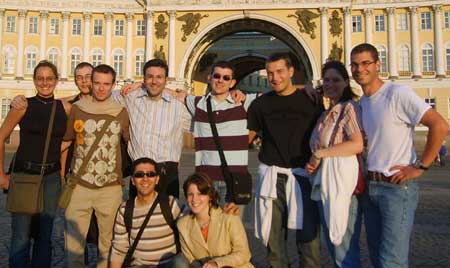
The French delegation in front of the Hermitage museum museum
This event is co-organized by the Young Generation Network of the French Nuclear Society (SFEN), with Isabelle POLI as a mission leader, and by the SREC (State Regional Educational Center) in Saint-Petersburg, with Olga MALETS as a leader.
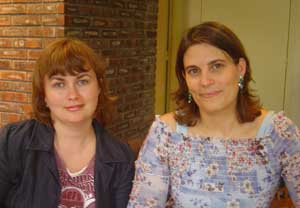
Olga MALETS (SREC) and Isabelle POLI (SFEN)
Each of the 2 weeks was organized and funded by each association. On the French side the overall settings was managed by YGN members as well as students from the ECAM engineering school.
The financial arrangement was possible for the French side thanks to the following generous sponsors:

RUSSIA (2nd to 8th of
July 2007)
(Non exhaustive)
Communication lectures with Dimitri GAVRA (Specialist from the state University of Saint-Petersburg)
Conferences on Russian nuclear perspectives
Visits Sosnovy-Bor RBMK NPP and ROSATOM communication centre in Saint-Petersburg
FRANCE (9th to15th of July 2007)
Visits:
BUGEY NPP (EDF) meeting with the head of the on-site communication body
VISIATOME (CEA), Communication center in Marcoule dealing with the discovery of radioactivity and its uses.
Phénix Sodium Cooled Fast Reactor (CEA), research on transmutation of nuclear wastes
Francis SORIN (SFEN): “Public debate about nuclear in France: what we learned?”
Olivier LAFFITTE (ANCLI): “Law on openness and nuclear safety. New roles of Local Information Commissions”
Marie KIRCHNER (Vice-Présidente du Pays du Cotentin) : "The citizens speak about the public debate "
Willy FOURNIER (Expert ex-CEA) : "Nuclear communication during 20 years: from public acceptance to public information"
Patrick SANDEVOIR (Directeur du Développement économique à la Chambre de Commerce de Nîmes) : “Nuclear and Economy : relations
Jean-Claude ARTUS (Professeur d’Université, chef de département du centre de médecine nucléaire de Montpellier): “Find and Solve the ‘obstacles’ of information”

Boreal Nights 4 - 11 July 2007 - Centrale nucléaire
de BUGY
http://www.euronuclear.org/e-news/e-news-18/ENC-YGN-workshop.htm

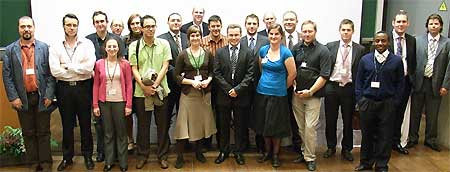
At ENC2007, the Young Generation Network of the ENS organized the workshop "Challenges and Opportunities for Nuclear Professionals".
The ENS YGN invited two speakers to introduce the topic from different perspectives. Gert Van den Eynde (SCK•CEN / BNEN, Belgium) focussed on the research and academic point of view. Marco Streit (ATEL, Switzerland) represented the nuclear industry and utilities. Both presentations were the perfect initiators of a lively discussion.
The debate was even more successful due to the varied and enthusiastic public. Thirty participants, fresh and experienced, from universities, research institutes and industry participated actively in the discussions until the chairman noticed it was high time for conclusions!
Nuclear professionals have a high market value! Opportunities are numerous. Energy needs are growing. There is a steep increase in requests for plant lifetime extension and in proposals for new builds, whereas a large generation of nuclear experts is retiring. Research opportunities preparing the next generation of nuclear systems are ample.
Qualified people are needed in times where engineering studies
aren't very hot and the public perception of nuclear not very positive.
The problem is even bigger for universities and institutes: the high need for
qualified people in the industry, results in a brain drain from research. This
is a severe challenge for the universities and institutes today.
Also, the retirement of the experienced generation in combination the generation
gap in nuclear industry complicate the transfer of know-how towards the new
nuclear professionals. Nuclear industry should be aware of this difficulty
and provide programmes to bridge the gap.
Nuclear education programmes are available in universities
and institutes, both at national and international level. They are set up
in a way a combination of study and work is possible. Universities and institutes
can organize specific programmes at the request of industry (while guaranteeing
the academic value!). Industry can sponsor engineering faculties and send
its people to universities.
Innovative projects attract young people. Large infrastructures are magnets
for new professionals. Research progresses science and provides sustainable
solutions.
By combining their efforts, research and industry can tackle the challenges above!
Young people interested in the nuclear field, should enter now. Opportunities to get the right qualification exist but own initiative and flexibility are needed. Don't wait until someone ask you but organize yourself to learn from experienced people and to share your own experiences with the others.
Research and industry should give their new professionals the opportunity to learn new things. They could set up mentoring programmes to bridge the generation gap. Encourage young people to network and convince your middle management to allow them to participate to conferences. Give young employees some freedom and let them take leadership!
http://www.euronuclear.org/e-news/e-news-18/sien.htm

During October 14 - 19 2007, Best Western Park - Bucharest hosted the International Symposium on Nuclear Energy – SIEN 2007: “Nuclear Power – A New Challenge”.
Organized by the Romanian Association “Nuclear Energy “ (AREN) and by the Romanian Atomic Forum (ROMATOM), and dedicated to the new trends in the nuclear power field, SIEN 2007 joined together the community of specialists in the nuclear field. The Symposium was attended by participants from different countries such as Canada, Italy, South Korea, France, Bulgaria and Belgium.
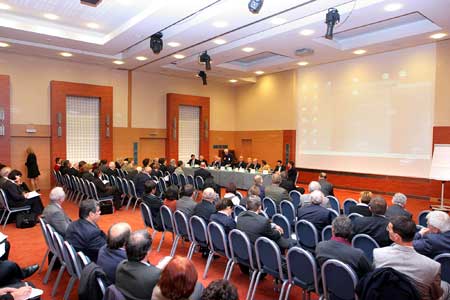
The Romanian research institutes and the “Politehnica” University also brought their contribution to the knowledge transfer and exchange by participating in this event.
The Symposium was opened to anyone interested in scientific, technical, financial and economic issues the evolution of nuclear power confronts us with, in the present background, out of which we mention the following:
Developing the new nuclear technologies;
Finding possibilities for nuclear programs developing;
Strengthening public confidence in nuclear power
SIEN 2007 succeeded the official inauguration of Cernavoda NPP Unit 2, on October 5, 2007, an important milestone in the Romanian energy policy.
SIEN 2007 brought together 150 participants and guests; 89 papers and 8 posters were presented within the following sessions:
Session 1: Developing the New Nuclear Technologies
Session 2: Operation, Inspection and Maintenance
Session 3: Increasing Nuclear Safety Features
Session 4: Fuel Cycle and Nuclear Wastes Management
Session 5: Public Acceptance and Confidence Strengthening
SIEN 2007 was also the framework of 3 workshops:
QA Management within the European Integration
Young Generation “ Building the Future”
WiN and the EU Nuclear Programs Developing
The Young Generation Workshop which addressed the issue: “Is nuclear
Romanian industry attractive for graduate students and young professionals?” was
attended by more than 20 participants from different companies or organizations
from the Romanian nuclear industry.
Also, in the WiN Workshop around 50 members participated. Based on the issues raised during the discussions in the workshop, proposals were made to solve them in a joint effort of communication, education and training.
SIEN 2007 was concluded with a speech given by the president of AREN, Mr. Ioan Rotaru who congratulated the participants and invited them to take part in SIEN 2009.
http://www.euronuclear.org/e-news/e-news-18/SNETP.htm


On 21 September 2007, the EC launched the much-anticipated Sustainable Nuclear Energy Technology Platform (SNETP). Janez Potocnik, the EU’s Science and Research Commissioner, kicked off the launch conference in front of an impressive gathering of researchers, politicians, industry representatives, EC officials and environmental groups. Commissioner Potocnik outlined the concept and role of Technology Platforms. He explained why the EC supports one for nuclear energy, emphasising the pivotal role that nuclear energy has to play in the EU’s energy mix and stressing that “…nuclear power will be a very important part of their solution to security of supply and the reduction of greenhouse gases.”
The overriding aim of the SNETP is to facilitate closer integration between researchers and industry to enable the definition and implementation of a Strategic Research Agenda (SRA) and its corresponding Deployment Strategy (DS). It will help to maintain Europe’s R&D leadership in the nuclear research sector and provide nuclear energy’s contribution to the Strategic Energy Technology Plan (SETP) that aims to develop research into all low-carbon technologies in the EU.
A strategic document entitled SNETP: A Vision Report was published to coincide with the launch. This report, which was compiled with the support of industry, research institutes and the Euratom Scientific and Technical Committee, underlines in detail the special contribution made by nuclear energy to ensuring security of energy supply, promoting competitiveness and fighting climate change. It also provides a roadmap for the creation of the Strategic Research Agenda (SRA), highlighting the start-up, by 2020, of a new breed of fast reactors (Generation IV), advanced recycling processes and the production of alternative fuels, like hydrogen. The report also stresses the need for increased resources for education and training in nuclear engineering.
Details of the upcoming agenda and work programme of the SNETP were also outlined. The first significant step in the process will be the setting up, by 30 October 2007, of a Governing Board, an Executive Committee and Working Groups focusing on specific research fields. The chairpersons of these bodies will be elected on the same day and will be entitled to attend the first meeting of ENEF on 26 & 27 November 2007, in Bratislava. In early December 2007, a meeting will be held to launch the SRA and the DS activities. The finalised SRA and DS will be presented one year later at the first General Assembly of the SNETP.
Following on from the setting up of the High-Level Group on Safety and Radioactive Waste and the creation of ENEF, this latest initiative further endorses nuclear energy’s key role in the EU’s energy mix and in tackling the problems of security of supply and climate change – a role now officially recognised by the EU institutions.
 |
After Commissioner Potocnik’s opening speech, the launch conference began with the first of 3 panel debates. First up was a debate entitled The Role of Nuclear Energy in Tackling EU Energy Challenges, which was chaired by Zoran Stancic, Deputy Director General of DG RTD. Among the |
panelists were MEP Romana. Jordan Cizelj (EPP-ED, Slovenia); MEP Philippe Busquin (PSE, Belgium) – a former EU Science and Research Commissioner – and Thomas Barrett, Director of the European Investment Bank (EIB)
The second panel debate was chaired by Deputy Director General of DG TREN, Dominique Ristori. It was entitled The Views of the Main Users of Nuclear Power and Heat and featured speakers from other industrial sectors and academia. These included Thierry De Bresson, Strategic Management, ALCAN (the metallurgy sector); Anders Hildeman, Vice President of SCA (paper and pulp industry), and Professor Jacques De Ruyck of the Vrije Universiteit Brussel (VUB), who had worked on the Commission 2030 Report for the Belgian government.
Finally, the third panel session was entitled The SNETP: from Vision Document to the Strategic Research Agenda and the Deployment Strategy. It was chaired by Simon Webster, Head of Unit DG RTD, J2 (Nuclear Fission). Among the speakers was Philippe Pradel of the CEA, who presented the Vision Report document; Roland Schenkel, Director General of the Joint Research Council (JRC) and Bernhard Fischer of E-ON.
Alain Bugat, Director General of the CEA, brought the conference to a close with a closing speech.
For further information about the launch event and the SNETP, you can consult:
the press release of the EC:
(www.europa.eu/rapid/pressReleasesAction.do?reference=
IP/07/1370&type=HTML&aged=0&language=EN&guiLanguage=en)
and the following websites:
www.snetp.eu;
ec.europa.eu/research/energy/fi/article_1121_en.htm
and
cordis.europa.eu/fp7/euratom/home_en.html
http://www.euronuclear.org/e-news/e-news-18/nas.htm

![]()
WASHINGTON -- The National Academy of Sciences (NAS) is making 150 years of American scientific history available by publishing its entire collection of Biographical Memoirs on the Internet. Biographical Memoirs are brief biographies of deceased NAS members written by those who knew them or their work.
Since 1877, NAS has published over 1,400 memoirs. Although the memoirs published since 1995 have been freely available on the Academy's Web site, over 900 memoirs were available previously only through archives and libraries. "This is a ‘historic’ event that will have substantial scholarly value and be of general interest to the public. This personal and scholarly view of the lives and work of such prominent scientists will be a wonderful resource," said John Brauman, home secretary of the Academy.
Among the additional 500 memoirs published online are those of famed naturalist Louis Agassiz; Joseph Henry, the first secretary of the Smithsonian Institution; Thomas Edison; Alexander Graham Bell; noted anthropologist Margaret Mead; and psychologist and philosopher John Dewey. More memoirs will be published regularly until the entire collection is available online. PDF files of each memoir are available online at www.nasonline.org/memoirs.
The National Academy of Sciences, founded in 1863, is an honorific society of distinguished scholars engaged in scientific and engineering research, dedicated to the furtherance of science and technology and to their use for the general welfare. Election to the Academy is considered is one of the highest honors that a U.S. scientist can receive.
www8.nationalacademies.org/onpinews/newsitem.aspx?RecordID=09102007
http://www.euronuclear.org/e-news/e-news-18/nucnet-news.htm


22 Oct (NucNet): The possible impact of climate change on electricity production in the US is likely to influence future technology choices and investments, according to a new report by the country's Climate Change Science Program (CCSP).
The report*, 'Effects of Climate Change on Energy Production and Use in the United States', was published on 18 October 2007 and is the third in a series. It evaluates emissions, energy and the economic implications of stabilising greenhouse gas concentrations.
According to the report, most of the impact on fossil and nuclear electricity components is likely to come from “modest changes” in water availability and/or cycle efficiency.
“Because renewable energy depends directly on ambient natural resources such as hydrological resources, wind patterns and intensity, and solar radiation, it is likely to be more sensitive to climate variability than fossil or nuclear energy systems that rely on geological stores,” says the report.
It says renewable energy sources are connected with climate change in “very complex ways”, adding: “Their use can affect the magnitude of climate change, while the magnitude of climate change can affect their prospects for use.”
“Of the two largest US renewable energy sources, hydroelectric power generation can be expected to be directly and significantly affected by climate change, while biomass power and fuel production impacts are less certain in the short term,” says the report.
The report says wind power is the fastest growing renewable energy technology in the US with total generation increasing to 14 billion kilowatt hours in 2005.
The coordinating lead author of the report, Thomas Wilbanks of the Department of Energy’s Oak Ridge National Laboratory, said: “This report represents the first overview of impact vulnerabilities, opportunities, and adaptive response issues for the energy sector in the United States.”
He said the report is notable because unlike some other sectors of interest regarding climate change – such as water, agriculture, and human health – the energy sector has not been the focus of climate impact discussions over the past decade.
The first report in the series was published in May 2007 by the US National Oceanic and Atmospheric Administration. US federal agencies plan to deliver the remaining 19 reports during the next year to increase scientific understanding related to climate change.
* The third report is available in full on the CCSP web site (www.climatescience.gov).
>> Related reports in the NucNet database (available to subscribers)
Report Endorses Nuclear’s ‘Mitigating Role’ In Climate Change (World Nuclear Review No. 18, 4 May 2007)
New Climate Change Report Considers ‘Widespread Development Of Nuclear’ (News No. 166, 11 July 2007)
The NucNet database currently contains around 12,000 reports published since 1991. To subscribe or ask for any further information email info@worldnuclear.org
Source: NucNet
Editor: john.shepherd@worldnuclear.org
Links to Member Societies
|
| Austrian
Nuclear Society |
Belgian
Nuclear Society |
| British
Nuclear Energy Society |
Bulgarian
Nuclear Society |
| Croatian
Nuclear Society |
Czech Nuclear Society |
| Danish
Nuclear Society (DKS) |
Finnish
Nuclear Society |
| French
Nuclear Energy Society (SFEN) |
German
Nuclear Society (KTG) |
| Hungarian
Nuclear Society |
The
Israel Nuclear Society |
| Italian
Nuclear Association |
Lithuanian
Nuclear Energy Association |
| Netherlands
Nuclear Society |
Polish
Nuclear Society |
| Romanian
Nuclear Energy Association (AREN) |
Nuclear
Society of Russia |
| Slovak
Nuclear Society |
Nuclear
Society of Slovenia |
| Spanish
Nuclear Society |
Swedish
Nuclear Society |
| Swiss
Nuclear Society |
Yugoslav
Nuclear Society http://www.vin.bg.ac.yu/ YUNS/index.html |
http://www.euronuclear.org/e-news/e-news-18/Corporate-Members.htm

Links to ENS Corporate Members
|
| Aare-Tessin
AG (ATEL) |
Alexandrov
Research Institute of Technology (NITI) |
| Ansaldo
Nucleare S.p.A |
Advanced
Measurement Technology Inc. |
| Andritz
AG |
AREVA
NP GmbH |
| SPE
Atomtex |
Belgonucleaire
|
| BKW
FMB Energie AG |
BNFL |
| Belgatom
|
Centralschweizerische
Kraftwerke (CKW) |
| Chubu
Electric Power Co. |
Comisión
Chilena de Energía Nuclear |
| Cybernétix
Group |
CCI
AG (formerly Sulzer Thermtec Ltd) |
| Colenco
Power Engineering AG, Nuclear Technology Department |
Commissariat
à l’Energie Atomique (CEA), Nuclear Energy Division |
| Design
Bureau "Promengineering" |
Eckert
& Ziegler Isotope Products GmbH |
NV Elektriciteits-Produktiemaatschappij
Zuid-Nederland EPZ (Electricity Generating Co. Ltd in the Southern Netherlands)
|
Energie
Ouest-Suisse (EOS) |
| E.O.N
Kernkraft GmbH |
Euro
Nuclear Services BV |
| ENS
Nuklear Services GmbH |
Electrabel,
Generation Department |
| Electricité
de France (EDF), Communication Division |
ENUSA
Industrias Avanzadas SA |
| EXCEL Services Corporation link |
Framatome
ANP (Advanced Nuclear Power) |
| Framatome
ANP, Inc |
GE
International, Inc., |
| GE Nuclear
Energy |
|
| Holtec
International |
IEA
of Japan Co. Ltd |
| Institut
National des Radioéléments, |
Japan Electric Power Information Center (JEPIC) link |
| Jozef
Stefan Institute |
Kernkraftwerk
Gösgen-Däniken AG |
| Kernkraftwerk
Leibstadt AG (KKL), |
Elektroinstitut
Milan Vidmar |
| L-3
Communications MAPPS Inc. |
Microfiltrex
- a Division of Porvair Filtration Group Ltd |
| Natsionalna
Electricheska Kompania (NEK) |
Nordostschweizerische
Kraftwerke (NOK) |
| NRG
Arnhem |
NRG
Petten |
| NUKEM
GmbH |
Nuklearna
Elektrarna Krsko |
|
Paks Nuclear Power Plant Ltd |
Paul
Scherrer Institute |
| Polimaster
Ltd |
RADOS
Technology Oy |
| Siempelkamp
Nukleartechnik GmbH |
SKB
(Swedish Nuclear Fuel and Waste Management Company) |
| Studsvik
AB |
SIAP
Analize d.o.o. |
| Studiecentrum
voor Kernenergie, Centre d’Etude de l’Energie Nucléaire
SCK/CEN |
Synatom
|
| Taiwan
Atomic Energy Council (AEC)
|
Taiwan
Power Company (Taipower) |
| Technicatome |
"Technoatomenergo"
Close Joint-Stock Company |
| Teollisuuden
Voima Oy / Industrial Power Company Ltd (TVO) |
Tokyo
Electric Power Co. (London Office) |
| UNESA |
Urenco
Limited |
| USEC
Inc. |
Vattenfall
AB |
| VTT
Nuclear |
Hans
Wälischmiller GmbH |
| World
Nuclear Association (WNA), |
Westinghouse
Electric Company |
| World
Association of Nuclear Operators (WANO), |
http://www.euronuclear.org/e-news/e-news-18/editorial.htm
Mark O’Donovan, Editor-in-Chief
Contributors to this Issue:
Helmuth Böck (Austrian Nulear Society)
Frank Deconinck (ENS)
Kirsten Epskamp (ENS)
Andrei Goicea (Nuclearelectrica S.A.)
Sam Henson - British Energy
Edouard Hourcade ( French SFEN YGN)
Marcel Maris (BNS)
Dubravko Pevec (Croatian Nuclear Society)
Otmar Promper (Austrian Nulear Society)
Frigyes Reisch, (KTH)
John Shepherd (NucNet)
Andrew Teller (Areva)
Katrien Van Tichelen (ENS YGN)
Marianne Wilson - Jacobs (BNES YGN)
Steven Wootten (British Energy)
Realisation:
Marion Brünglinghaus
Rue de la Loi 57, BE-1040 Brussels
Phone +32 2 505 30 50 - Fax: +32 2 502 39 02
E-mail: ens@euronuclear.org - http://www.euronuclear.org
The ENS News is a quarterly publication, in electronic
form only.
Copyright notice ©2007 European Nuclear Society.
Reproduction is authorised provided that the ENS News is acknowledged as the
source – except where otherwise stated.
![]()
© European Nuclear Society, 2007